This post may contain affiliate links. Please read our disclosure policy.
This chickpea flour pasta contains just two ingredients and is dairy-free, vegan, high-fiber, gluten-free, and perfect for serving with all your favorite pasta sauces! Use the homemade chickpea pasta immediately or save it for months, dried or frozen!
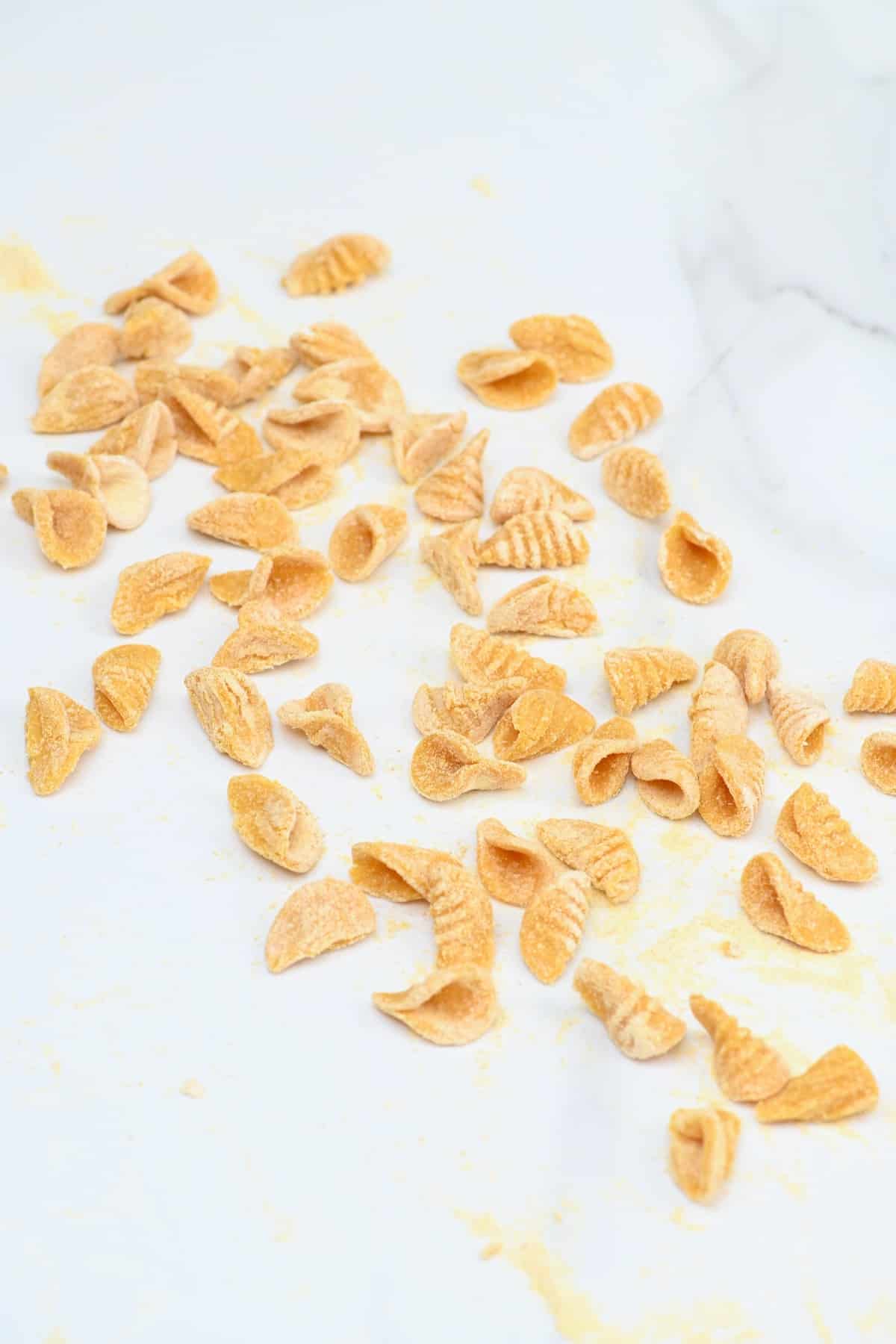
Though I’ve already shared vegan pasta (not gluten-free), oat pasta and red lentil pasta (gluten-free with vegan optional) – this chickpea flour pasta is both gluten-free and vegan and contains just two ingredients (with an optional third). In just 20 minutes, you can prep this chickpea pasta from scratch, add another 7-8 minutes for cooking it, and you have yourself a delicious, nutritious pasta dish any day of the week!
I actually shared the process for making chickpea flour almost a year ago, always with the idea of one-day making chickpea pasta with it. It may have taken slightly longer than expected, but I’m so happy I finally took the plunge. And since homemade gluten-free pasta can be a bit fiddly to deal with – check out some top tips for dealing with gluten-free pasta here.
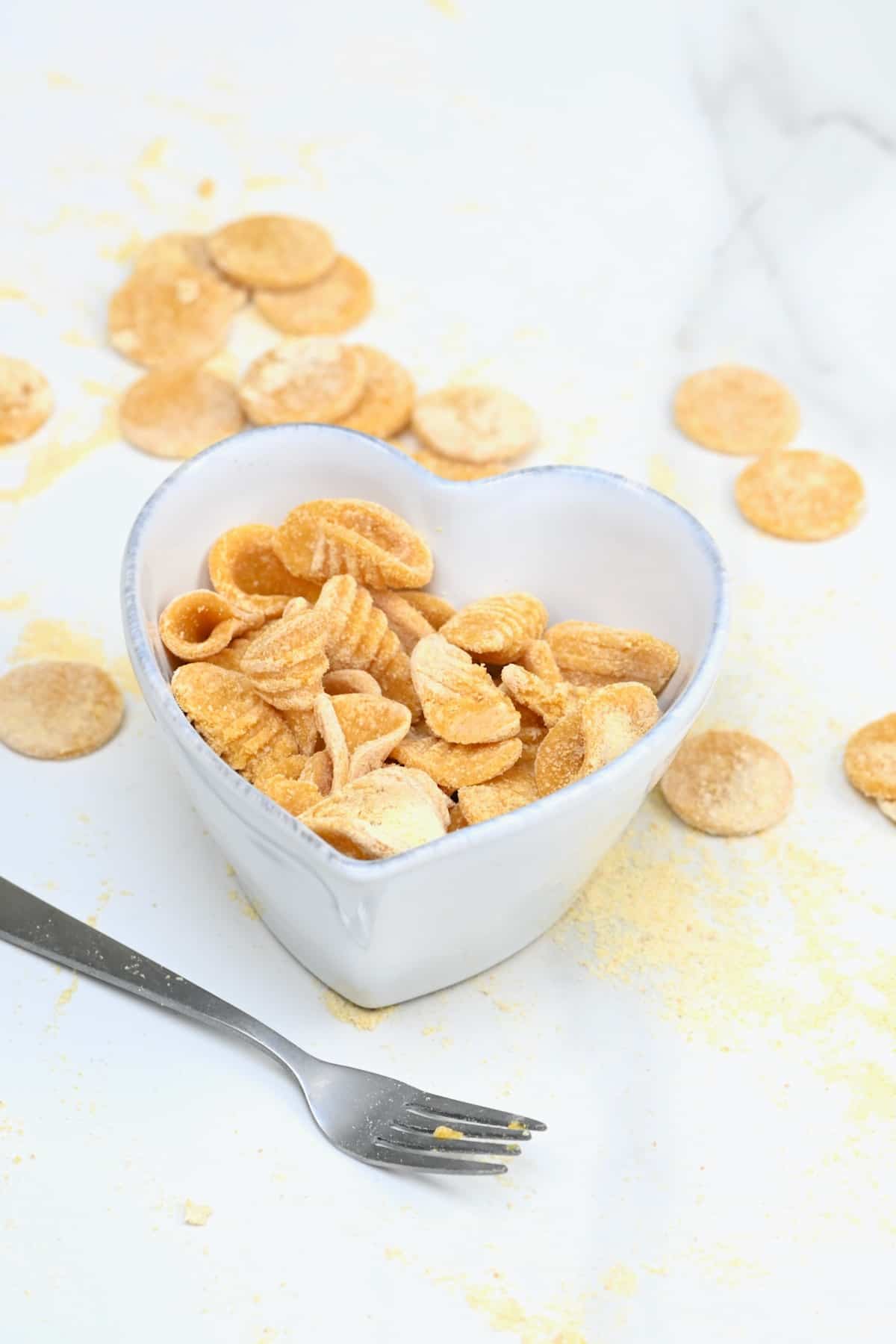
Chickpea flour pasta is one of the “free-from” pasta options that has gained a lot of popularity in the last few years, and it’s not hard to see why. It’s inexpensive, high-protein, high-fiber, packed with nutrients, and tasty. But who knew that it would be so easy to make at home too?!
Best of all, when making homemade pasta, you have the option of shaping it in all sorts of ways: ribbon noodles, bows, disks, etc. Below I’ve gone with something between gnocchetti and shell-shapes.
Want to save this recipe?
Ingredients for chickpea pasta
- Chickpea Flour – I use homemade chickpea flour (also called gram flour) – but feel free to use store-bought.
- Water – use tap or filtered water- whichever you prefer. Using slightly warm water is best but not 100% necessary.
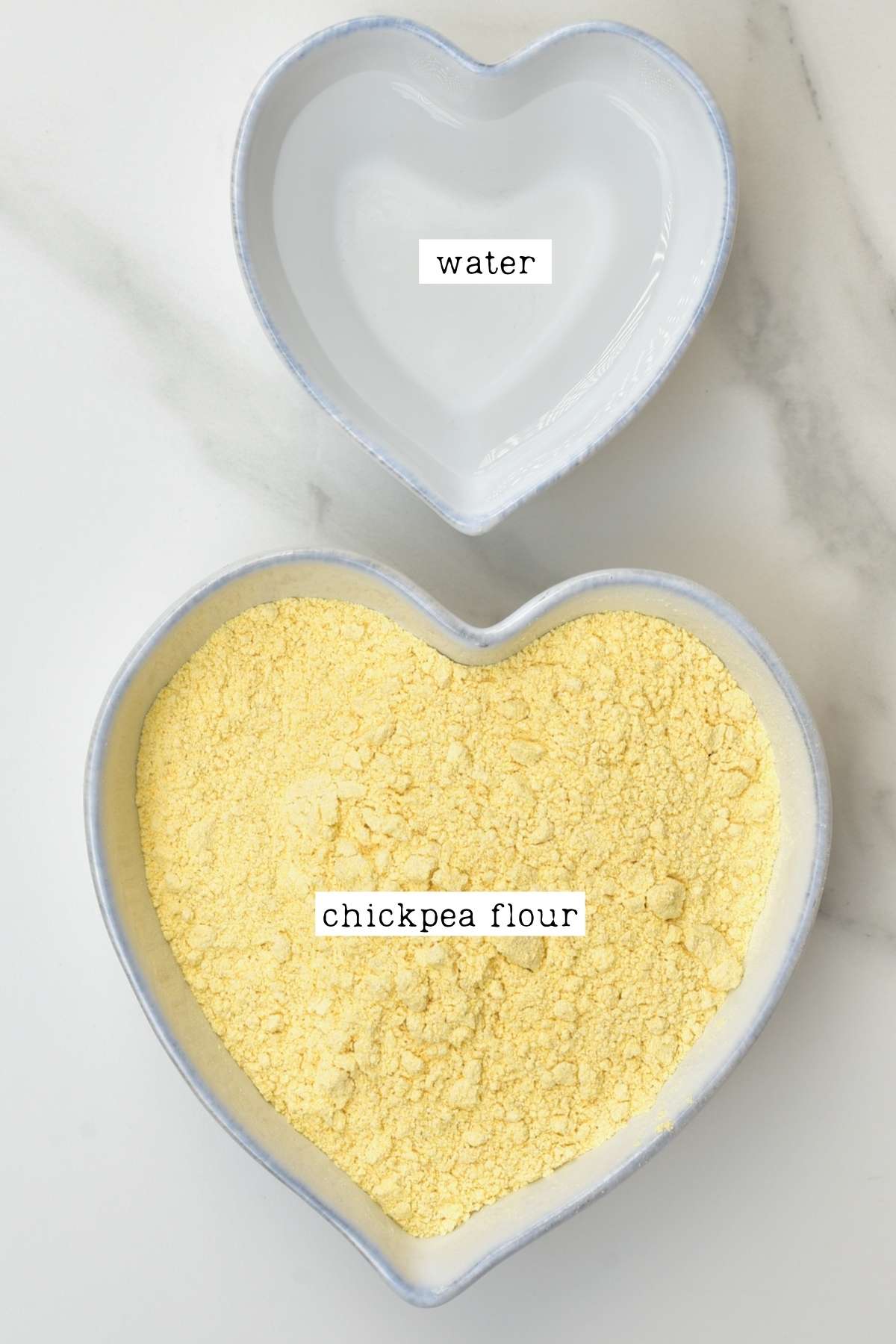
Optional ingredients
- Tapioca flour – will help to yield a more malleable dough. Replace around 1/4 cup of the chickpea flour with tapioca flour and optionally add in the xanthan gum (mentioned below) for dough that’s easier to work with (best if you want to create thin noodles and pasta shapes that could cause the gluten-free dough to crumble.
- Xanthan Gum – I specifically made this pasta with just chickpea and water to prove that it’s possible. However, the dough is quite fiddly – if you want it to be a little easier to work with (thus easier to shape to other types of pasta), you may want to add 1 tsp xanthan gum (which mimics the properties of gluten somewhat).
- Salt – just a pinch of salt can help enhance the flavor of this homemade chickpea pasta. However, I’ll usually omit it in the dough and salt the pasta while cooking and within the sauce/accompaniments.
Note: adding olive oil or another oil (fat) to pasta dough can also help it to be more supple and easier to roll out – as I have done with this oat pasta. Feel free to experiment if you’d like!
How To make chickpea flour pasta
Step 1: Prepare the chickpea flour dough
You can do this process on a work surface, within a bowl, or even with a stand mixer.
Combine the flour and water and form a dough, kneading well to obtain a uniform texture. Though this chickpea flour pasta doesn’t contain gluten, kneading is still important for a smooth dough.
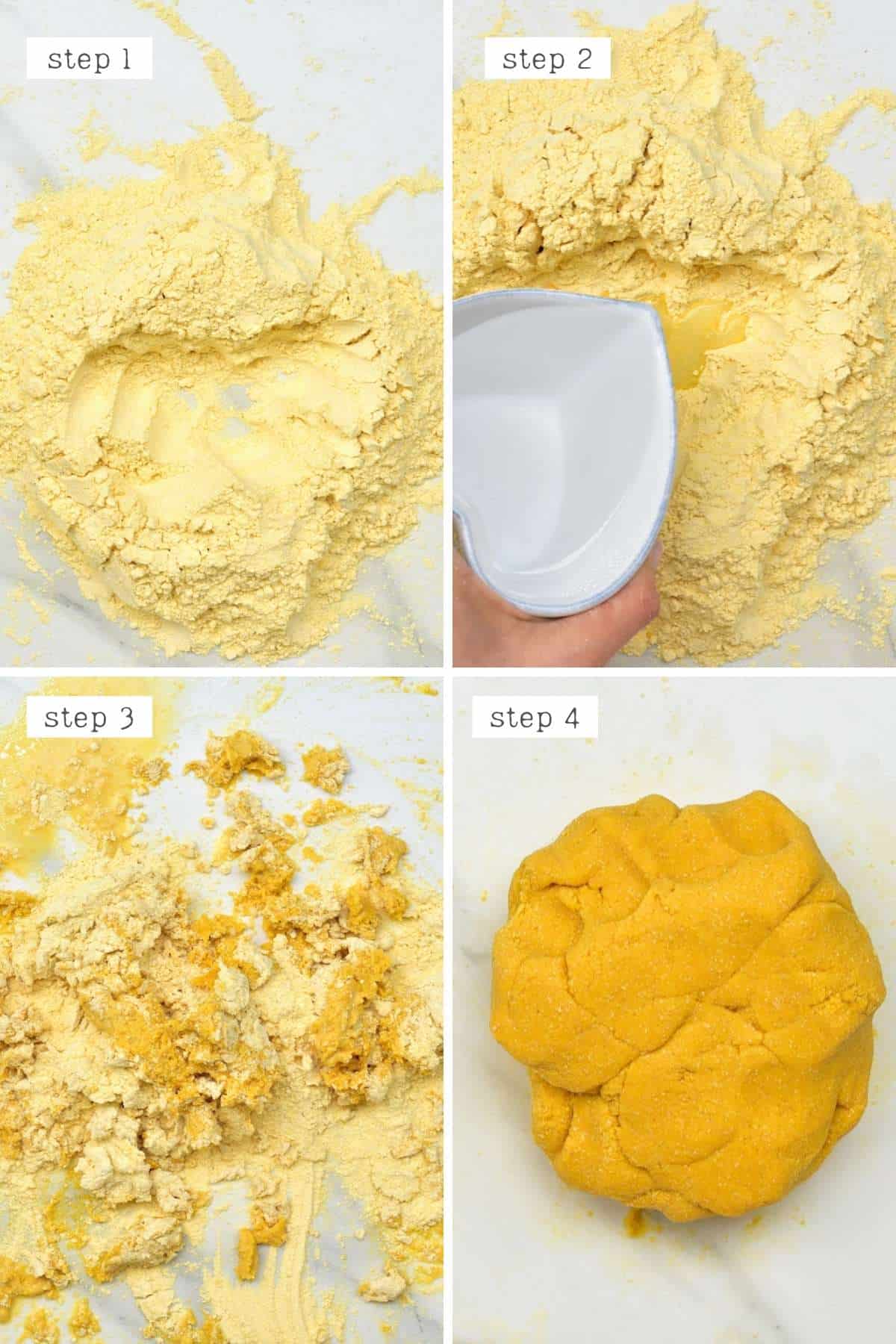
Form into a ball and then set the dough aside in a covered bowl/ wrapped in cling film for 10-15 minutes to rest. Technically, as this pasta doesn’t contain gluten, I’m not sure this resting step is necessary, but I like to think that the extra time for the flour to hydrate makes for a slightly stronger dough, so I like to rest it for a little while at least.
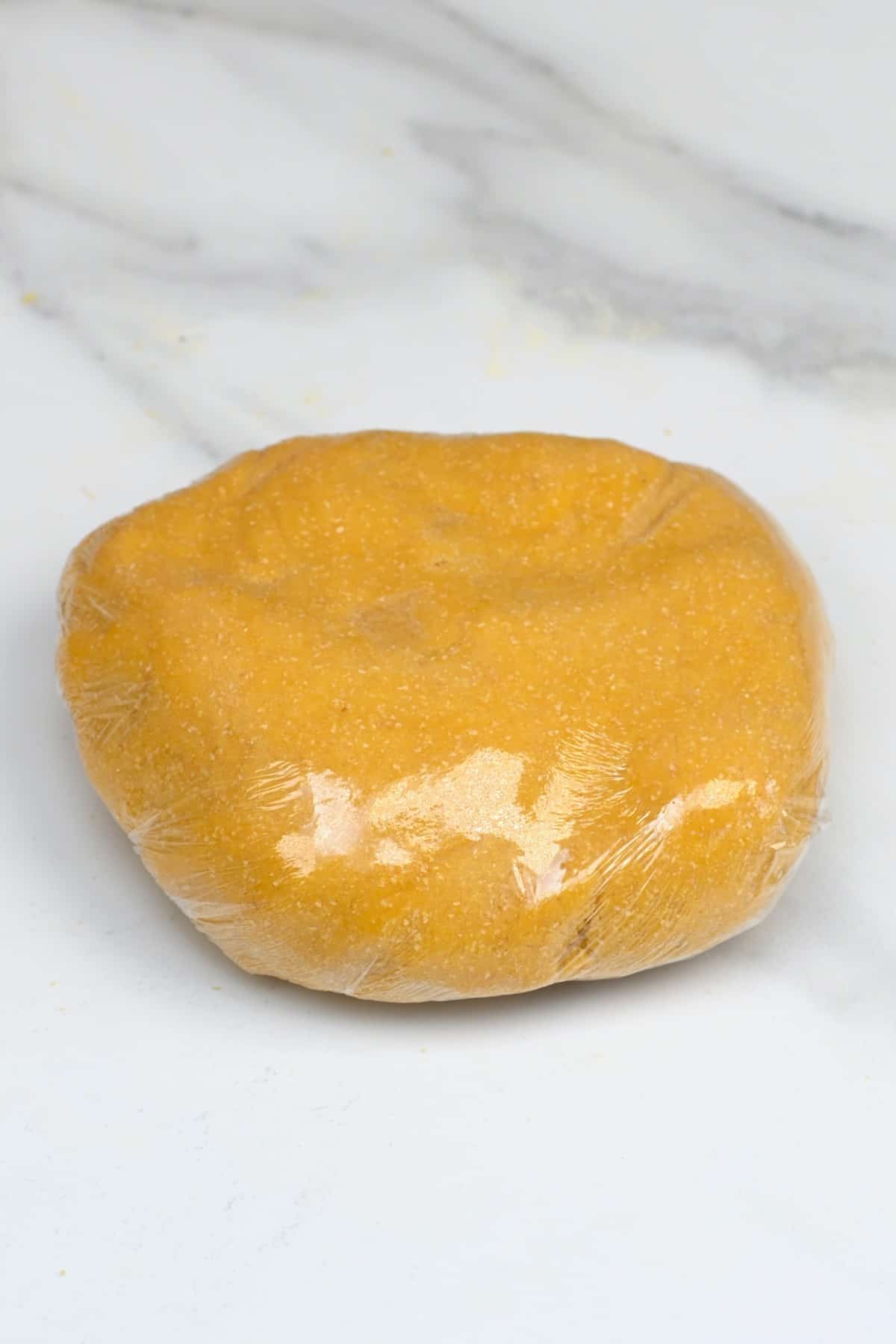
If you find that the dough is a little too crumbly, you can add some additional water. Add one tablespoon at a time until it forms a dough.
Step 2: Shape/Chop your homemade chickpea pasta
You can shape/chop the oat flour pasta either by hand with a rolling pin or a pasta machine.
First, divide the dough into 4-6 pieces – this will make it more manageable to work with as you roll each section into pasta sheets.
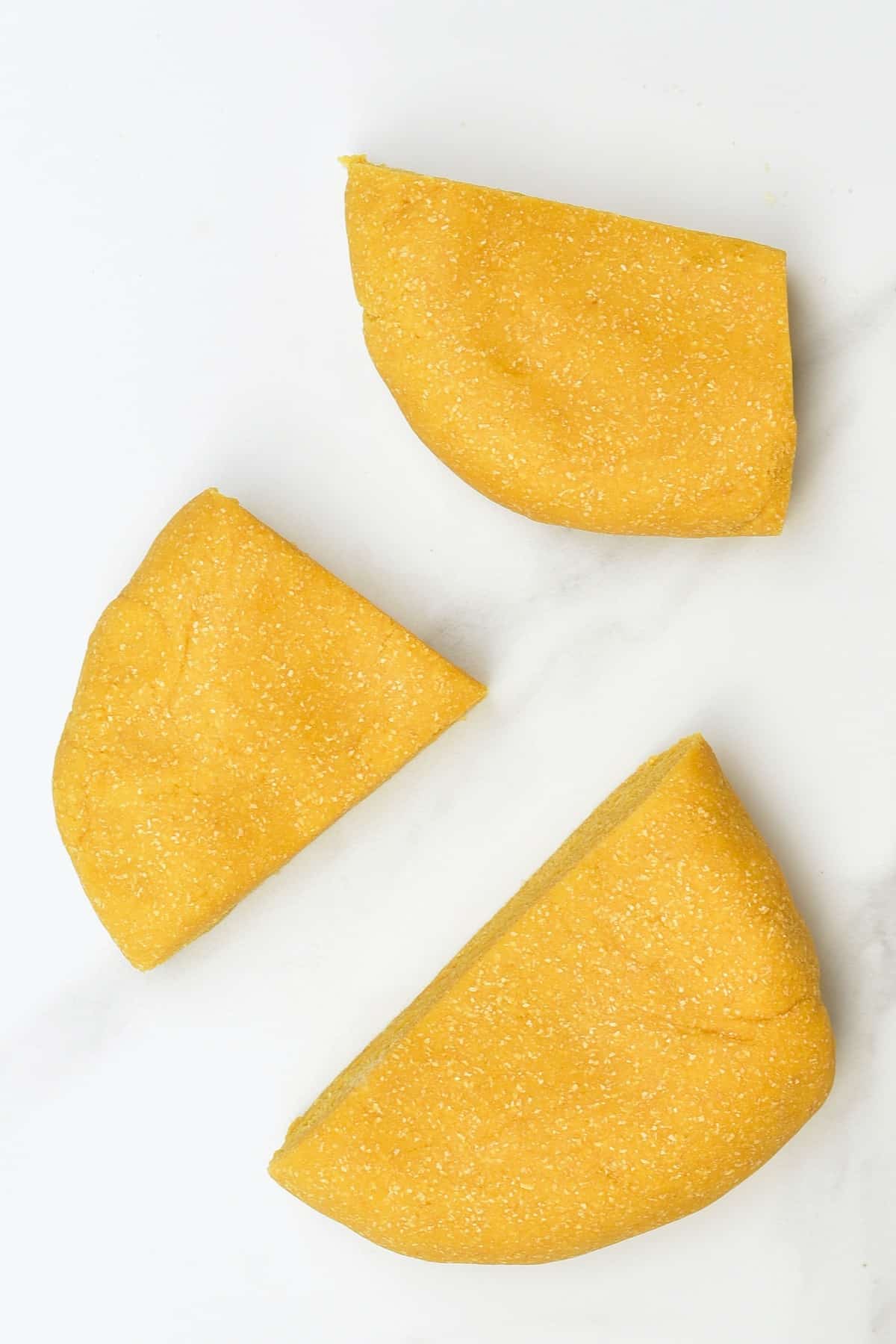
Dust your work surface with a little extra chickpea flour, and then use a rolling pin to roll out the pieces into a thin long strip. If you want to do this by hand, continue to roll until you reach your desired thickness – I usually aim for around 3mm when hand-rolling.
Alternatively, you can use a pasta machine, feeding it through from the thickest section, working your way to your desired thickness.
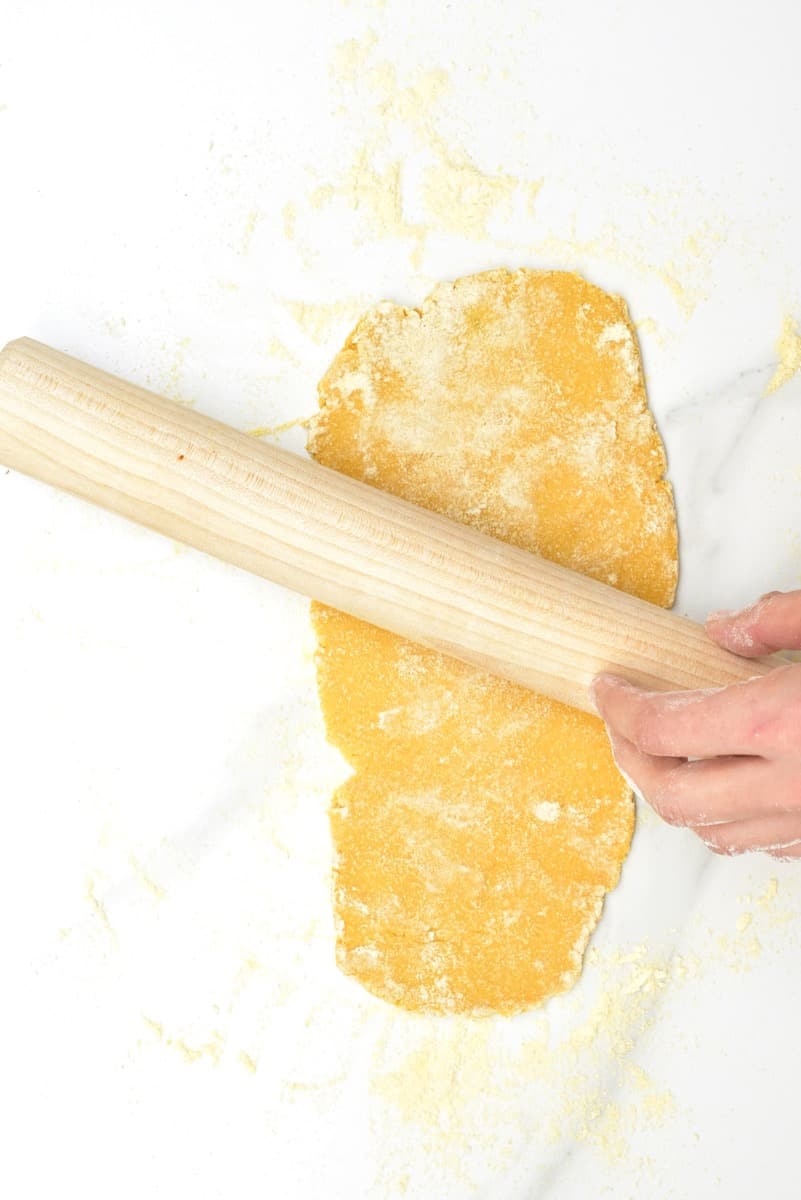
For tagliatelle/pappardelle style noodles, flour the dough sheet well, roll it up, and then slice into noodles of your desired thickness. Feel free to trim off the uneven edges first (check notes for how to use these scraps).
This method is easiest to do with the additional xanthan gum and/or tapioca starch. With just flour and water, roll the sheet out flat on the table and cut the noodles as it lays flat, rather than rolled up.
This time around, I decided to make a simple round pasta shape somewhat between gnocchetti and shell-shapes (it might have a name, but I’m not sure what it is). I first used a small round cutter to cut out lots of disks, then used a fork to roll them over, pinching two sides in to connect (refer to images).
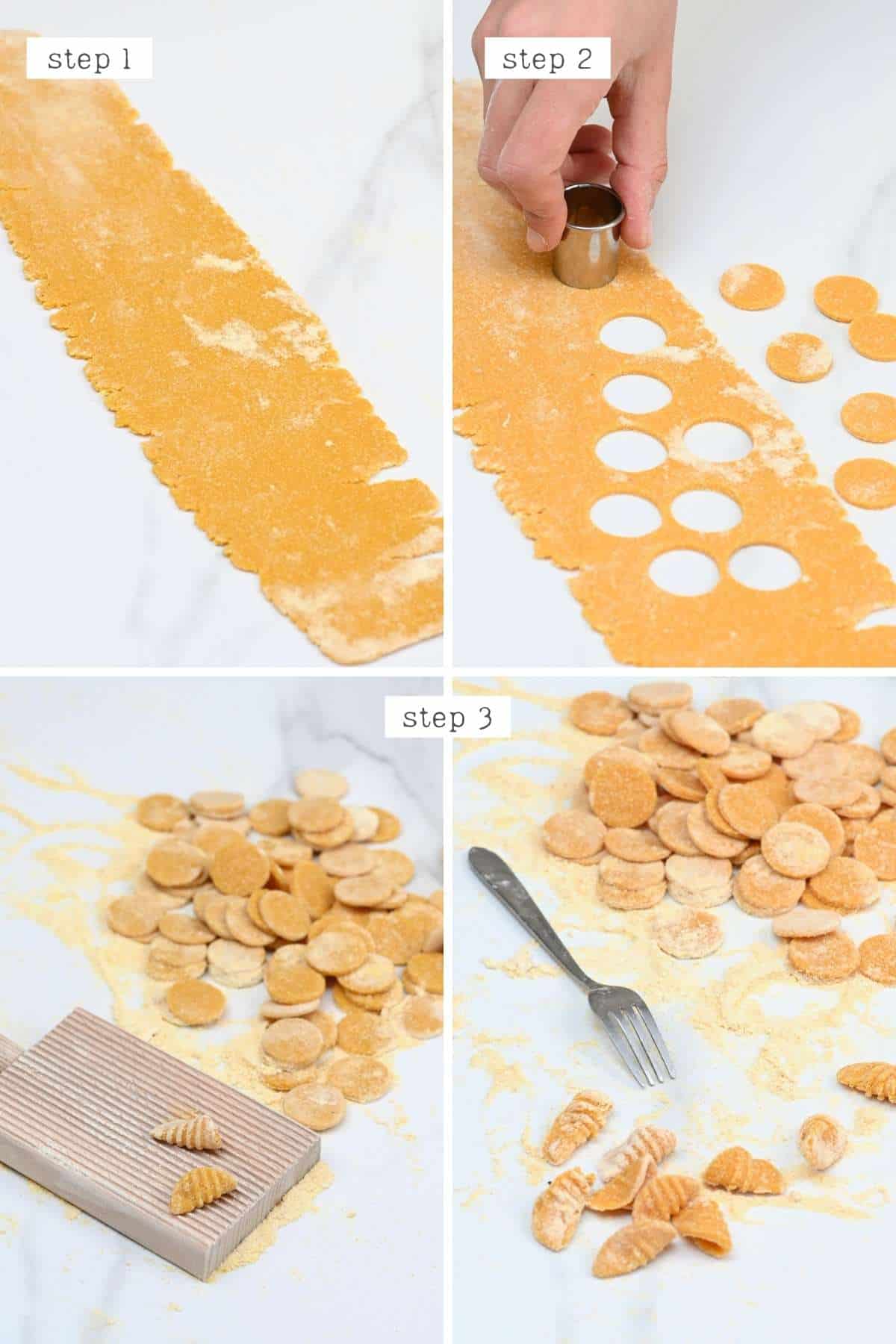
There is a wooden pasta tool you can use instead of the fork, but I found the fork easier for this chick flour pasta dough.
At this point, you can either spread them across a tray and leave them to dry out (or do so with a dehydrator) or proceed with cooking the chickpea pasta!
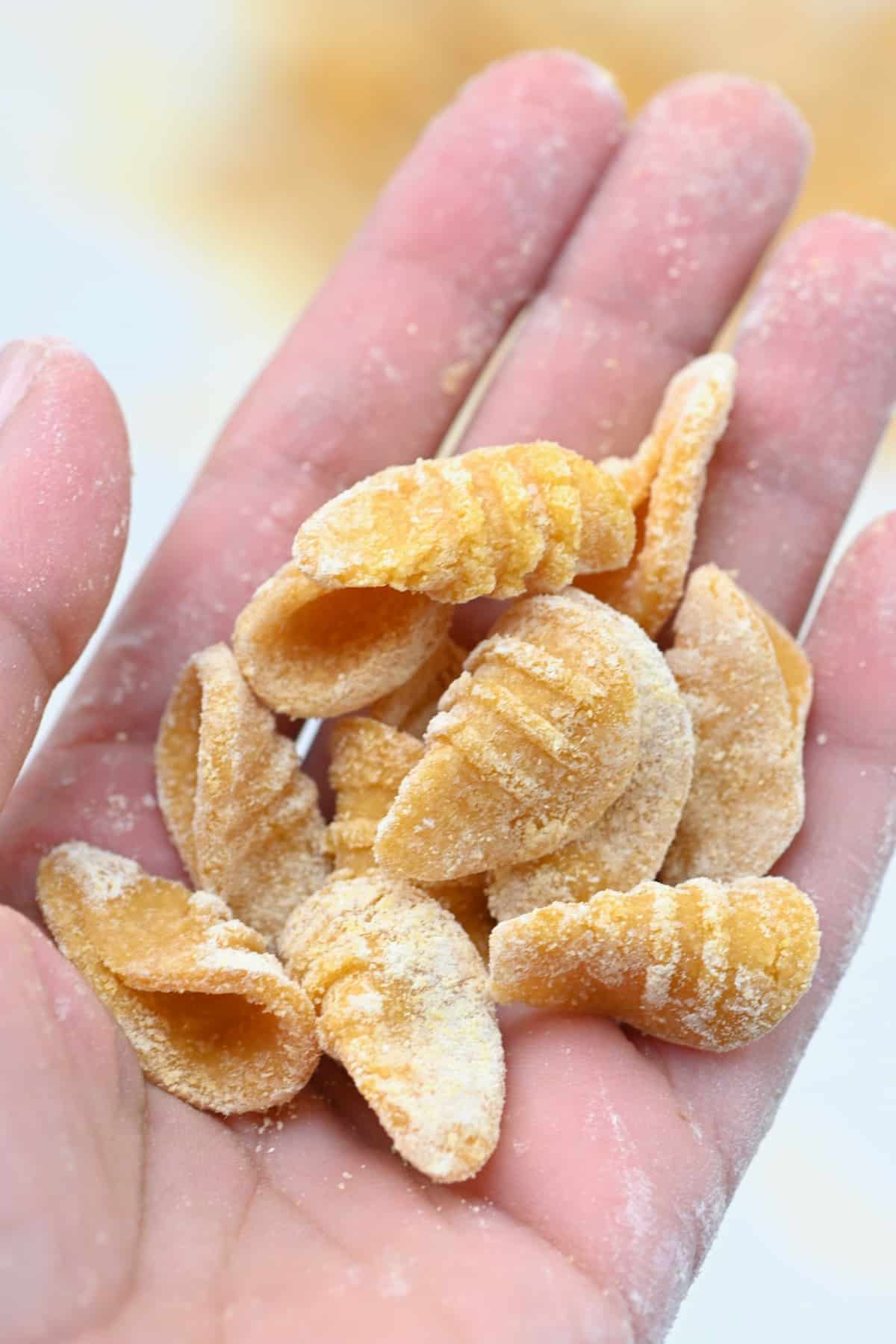
How To Cook Homemade Chickpea Pasta
To cook the pasta, bring a pot of salted water to a boil and add the pasta. Cook it for between 7-8 minutes, until al-dente. Stir every minute or so to make sure the chickpea pasta doesn’t stick together.
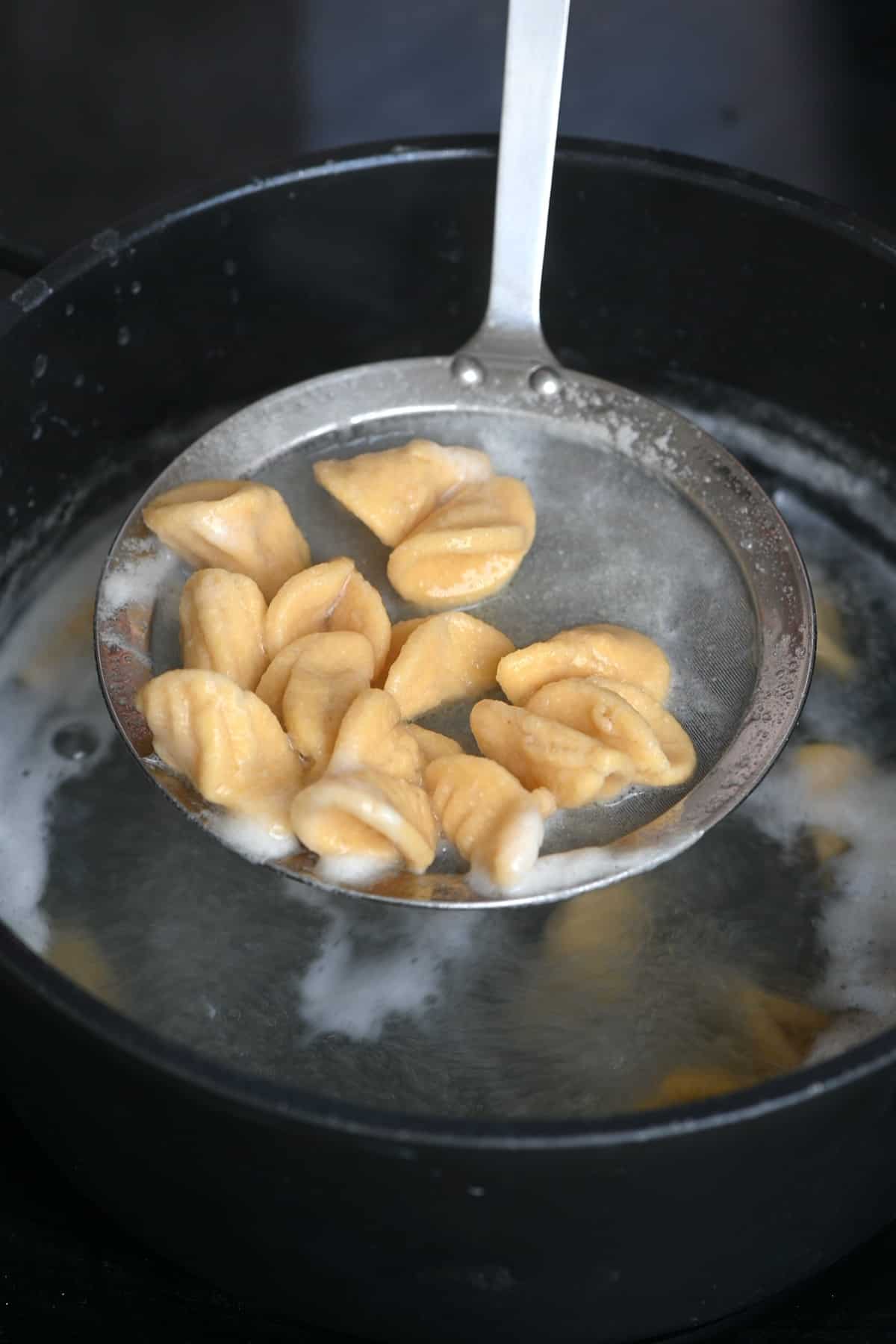
Once cooked, drain the pasta, and enjoy it with a little butter and parmesan (or dairy-free butter and nutritional yeast for a vegan option) or your sauce of choice (options listed below).
To Dry The Pasta
Lay the pasta out on a large tray in a well-ventilated area and dry until no longer pliable. You could also use a dehydrator for this – refer to manufacturer guidance for advice on times and temperatures. I tend to leave it to dry overnight, check in the morning, and continue as needed.
If you live in a particularly humid or cold area, I would suggest simply storing the pasta in the freezer as drying may not be possible.

How to serve
You can enjoy this chickpea pasta recipe with all of your favorite pasta toppings, including:
- Easy Vegan Bolognese (Spaghetti Sauce)
- Creamy Avocado Pasta Sauce (Green Pasta)
- Vegan Wild Mushroom Ragu
- Simple Roasted Red Pepper Sauce
- Super Creamy Vegan Mushroom Sauce Pasta
- Easy And Delicious Marinara Sauce Recipe
- Delicious Vegan Basil Pesto (with pistachios)
You could also use it for dishes like this baked feta and tomato pasta or cold pasta salads. I also like to use leftover creamy hummus as a quick pasta sauce.
How to store
Store: The fresh chickpea flour pasta will store in an airtight container in the fridge for 1-2 days. Alternatively, freeze it for between 3-4 months.
Dry: For longer-term storage, you could probably dry the pasta and then store it in an airtight container in a cool location. I haven’t actually tried to do so yet with this pasta, but have had great success with all my previous pasta varieties. Use it within 1-2 months. Alternatively, freeze for up to 6 months.
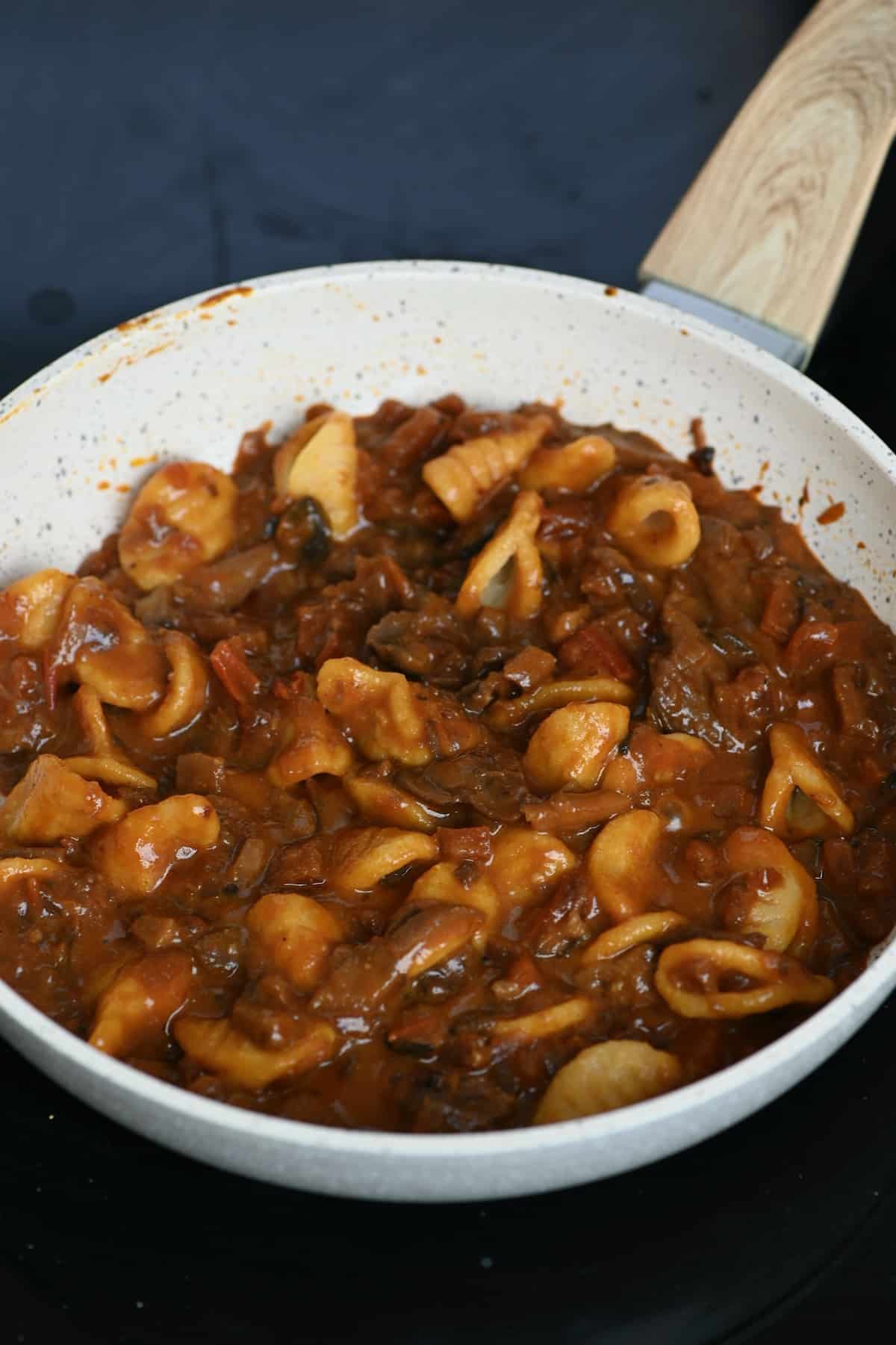
Recipe notes
- Don’t throw away the leftover salty pasta water! It can be left to cool and poured into an ice-cube tray to freeze. You can then use within stocks, soups, etc.
- If you want to make more complicated pasta shapes, it’s best to include the tapioca starch and/or xanthan gum. This will make it more pliable and less likely to crumble. Especially if you plan on using a pasta ‘press.’
- To use the pasta dough scraps. Gather all of the pasta scraps and either roll them into new shapes OR roll them into thin ropes. Then, chop them into small pieces, and press each piece into little ‘orecchiette’ style disks with your thumb. These can easily be added to soups and stews.
- If you include tapioca flour and/or xanthan gum, make sure to rest the dough for 30 minutes.
Other Pasta Recipes
- How To Make Vegan Pasta At Home
- Homemade Pappardelle Floral Pasta & Basil Pesto
- Fresh Homemade Spinach Green Pasta Salad
- Homemade Lentil Pasta (GF, Vegan)
- How To Make Oat pasta (3 Ingredient Gluten-free Pasta)
- All-Natural Homemade Rainbow Pasta
- How to Make Beet Pasta (Pink Pasta Recipe)
- How to Make Spinach Noodles (Green Pasta Dough)
- How To Make Homemade Pasta (Egg Pasta)
If you try this chickpea pasta recipe, then let me know your thoughts and questions in the comments. I’d also really appreciate a recipe rating and would love to see your recreations – just tag @AlphaFoodie.
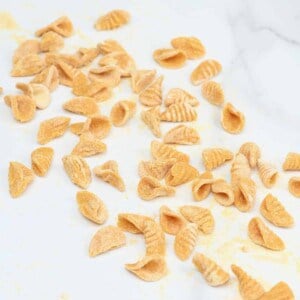
How To Make Chickpea Flour Pasta
Equipment
- Pasta machine -OR-
Ingredients
- 11 oz chickpea flour
- 3/4 cups water
Optional Ingredients
- 1 tsp xanthan gum For a more pliable dough (read notes)
- 1/4 cup tapioca flour Replace 1/4 cup chickpea flour with tapioca flour – for more pliable dough
Instructions
Step 1: Prepare the pasta dough
- You can do this process on a work surface, within a bowl, or even with a stand mixer.Combine the flour and water and form a dough, kneading well to obtain a uniform texture. Though this chickpea flour pasta doesn't contain gluten, kneading is still important for a smooth dough.
- Form into a ball and then set the dough aside in a bowl/in cling film for 10-15 minutes, to rest. Technically, as this pasta doesn't contain gluten, I'm not even sure this resting step is necessary, but I like to think that the extra time for the flour to hydrate makes for a slightly stronger dough, so I like to rest it for a little while at least.If you find that the dough is a little too crumbly, then you can add some additional water. Add one tablespoon at a time until it forms a dough.
Step 2: Shape/Chop your homemade chickpea pasta
- You can shape/chop the oat flour pasta either by hand with a rolling pin or with a pasta machine.
- Divide the dough into 4-6 pieces – this will make it more manageable to work with as you roll each section into pasta sheets.
- Dust your work surface with a little extra chickpea flour, and then use a rolling pin to roll out the pieces into a thin long strip. If you want to do this by hand, simply continue to roll until you reach your desired thickness – I usually aim for around 3mm when hand-rolling.Alternatively, you can use a pasta machine, feeding it through from the thickest section, working your way to your desired thickness.
- For tagliatelle/pappardelle style noodles, flour the dough sheet well, roll it up, and then slice into noodles of your desired thickness. Feel free to trim off the uneven edges first (check notes for how to use these scraps).This method is easiest to do with the additional xanthan gum and/or tapioca starch. With just flour and water, simply roll the sheet out flat on the table and cut the noodles as it lays flat, rather than rolled up.
- This time around, I decided to make a simple round pasta shape similar to gnocchetti/shell-shaped (it might have a name, but I'm not sure what it is). I first used a small round cutter to cut out lots of disks, then used a fork to roll them over, pinching two sides in, to connect (refer to images).There is a wooden pasta tool you can use instead of the fork, but I found the fork easier for this chickpea flour pasta dough.
- At this point, you can either spread them across a tray and leave them to dry out (or do so with a dehydrator), or proceed with cooking the chickpea pasta!
How To Cook Homemade Chickpea Pasta
- To cook the pasta, bring a pot of salted water to a boil and then add the pasta. Cook it for between 7-8 minutes, until al-dente. Stir every minute or so, just to make sure the chickpea pasta doesn't stick together.
- Once cooked, drain the pasta, and enjoy it with a little butter and parmesan (or dairy-free butter and nutritional yeast for a vegan option), or your sauce of choice (options listed below).
To Dry The Pasta
- Lay the pasta out on a large tray in a well-ventilated area and dry until no longer pliable. You could also use a dehydrator for this – refer to manufacturer guidance for advice on times and temperatures. I tend to leave it to dry overnight, check in the morning, and continue as needed.If you live in a particularly humid or cold area then I would suggest simply storing the pasta in the freezer as drying may not be possible.
How To Store
- Store: The fresh chickpea flour pasta will store in an airtight container in the fridge for 1-2 days. Alternatively, freeze it for between 3-4 months. Dry: For longer-term storage, you could probably dry the pasta and then store it in an airtight container in a cool location. I haven't actually tried to do so yet with this pasta, but have had great success with all my previous pasta varieties. Use it within 1-2 months. Alternatively, freeze for up to 6 months.
Notes
- Tapioca flour – will help to yield a more malleable dough. Replace around 1/4 cup of the chickpea flour with tapioca flour and optionally add in the xanthan gum (mentioned below) for dough that’s easier to work with (best if you want to create thin noodles and pasta shapes that could cause the gluten-free dough to crumble.
- Xanthan gum – I specifically made this pasta with just chickpea and water, to prove that it’s possible. However, the dough is quite fiddly – if you want it to be a little easier to work with (thus easier to shape to other types of pasta), you may want to add 1 tsp xanthan gum (which mimics the properties of gluten somewhat).
- Salt – just a pinch of salt can help enhance the flavor of this homemade chickpea pasta. However, I’ll usually omit it in the dough and just salt the pasta while cooking and within the sauce/accompaniments.
- Don’t throw away the leftover salty pasta water! It can be left to cool and poured into an ice-cube tray to freeze and then use within stocks, soups, etc.
- If you want to make more complicated pasta shapes It’s best to include the tapioca starch and/or xanthan gum to make it more pliable and less likely to crumble. Especially if you plan on using a pasta ‘press’.
- To use the pasta dough scraps. Gather all of the pasta scraps and either roll them into new shapes OR, roll them into thin ropes, chop them into small pieces, and press each piece into little ‘orecchiette’ style disks with your thumb. These can easily be added to soups and stews.
- If you include tapioca flour and/or xanthan gum, make sure to rest the dough for 30 minutes.
Nutrition
Nutrition information is automatically calculated, so should only be used as an approximation.

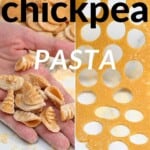

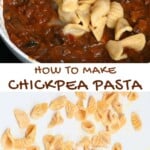
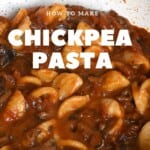
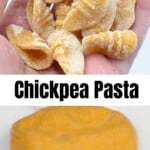
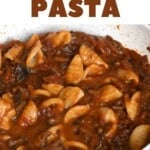

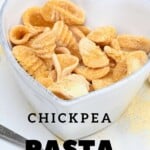
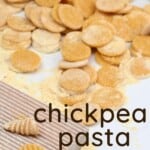









The 11 oz of chickpea flour, is that by weight or volume?
Hi Deanna,
It’s 11 oz of chickpea flour by weight.
I hope you give it a try!
The pasta was a little too sticky. I think it is because the 6 oz or 3/4 cup of water was too much. It made it hard to roll out. I used more chickpea flour to compensate for the stickiness of the dough. It did make a good noodle when cooked. I also opted to use 1 tsp of Xanthan Gum. Next time I will try making it with 4 oz of water instead of 6 oz.
Hi Erin,
Thank you so much for your comment and feedback.
Glad you will give it another try!
Delicious recipe, thanks very much – and any advice on making a ‘rice’ shape so I can make risotto with it?
Hey Catherine! You can totally make a ‘rice’ shape by rolling out the chickpea dough thin and cutting it into tiny squares. If you have a pasta maker, that makes it even easier! Just cook them in broth, but keep an eye on them since they’ll cook a lot faster than regular rice. Hope that helps!
I’m not vegan, but love this idea of extra protein. I wonder if I could use eggs rather than water to make the dough?
Hey Karine! That’s a great idea! Yes, you can use eggs instead of water to make the dough, which would add extra protein and give the pasta a slightly richer texture. Since eggs provide both moisture and structure, you may need less liquid overall, so start with one egg per 1X batch and adjust as needed to get a smooth, pliable dough.
Let me know if you give it a try—I’d love to hear how it turns out!
Thank you for the recipe. You mentioned in the notes that adding oil makes the dough easier to work with. You do not give us a measurement for any of the 1, 2, or 3X amounts. What measurement would you recommend for your recipe?
Hi Victoria,
You can use 1-2 Tablesponf of oil if wanted. Let me know how it goes if you give it a try!
This is great. I may not use the tapioca flour next time. Didnt care for the tast of it or will use less. But I made cavatelli out of it and boiled it in veggie broth. So good. Thanks. This is my go to pasta now.
Thank you for your comment, Lynn!
Hi,
Thanks for the recipe! Is it possible to substitute arrowroot powder for tapioca flour?
Thanks in advance!
Hey Patricia! You’re very welcome! Yes, you can substitute arrowroot powder for tapioca flour in this recipe. Both act as starches and help with binding, though tapioca tends to give a slightly more elastic texture. Arrowroot should still work well, but the pasta may be a little more delicate. Hope that helps